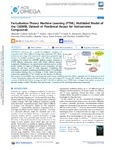Mostrar o rexistro simple do ítem
Perturbation-Theory Machine Learning (PTML) Multilabel Model of the ChEMBL Dataset of Preclinical Assays for Antisarcoma Compounds
| dc.contributor.author | Cabrera-Andrade, Alejandro | |
| dc.contributor.author | López-Cortés, Andrés | |
| dc.contributor.author | Munteanu, Cristian-Robert | |
| dc.contributor.author | Pazos, A. | |
| dc.contributor.author | Pérez-Castillo, Yunierkis | |
| dc.contributor.author | Tejera, Eduardo | |
| dc.contributor.author | Arrasate, Sonia | |
| dc.contributor.author | González-Díaz, Humberto | |
| dc.date.accessioned | 2020-11-24T10:12:54Z | |
| dc.date.available | 2020-11-24T10:12:54Z | |
| dc.date.issued | 2020-10-14 | |
| dc.identifier.citation | Cabrera-Andrade A, López-Cortés A, Munteanu CR, et al. Perturbation-Theory Machine Learning (PTML) Multilabel Model of the ChEMBL Dataset of Preclinical Assays for Antisarcoma Compounds. ACS Omega. 2020; 5(42):27211-27220 | es_ES |
| dc.identifier.issn | 2470-1343 | |
| dc.identifier.uri | http://hdl.handle.net/2183/26747 | |
| dc.description.abstract | [Abstract] Sarcomas are a group of malignant neoplasms of connective tissue with a different etiology than carcinomas. The efforts to discover new drugs with antisarcoma activity have generated large datasets of multiple preclinical assays with different experimental conditions. For instance, the ChEMBL database contains outcomes of 37,919 different antisarcoma assays with 34,955 different chemical compounds. Furthermore, the experimental conditions reported in this dataset include 157 types of biological activity parameters, 36 drug targets, 43 cell lines, and 17 assay organisms. Considering this information, we propose combining perturbation theory (PT) principles with machine learning (ML) to develop a PTML model to predict antisarcoma compounds. PTML models use one function of reference that measures the probability of a drug being active under certain conditions (protein, cell line, organism, etc.). In this paper, we used a linear discriminant analysis and neural network to train and compare PT and non-PT models. All the explored models have an accuracy of 89.19–95.25% for training and 89.22–95.46% in validation sets. PTML-based strategies have similar accuracy but generate simplest models. Therefore, they may become a versatile tool for predicting antisarcoma compounds. | es_ES |
| dc.description.sponsorship | Ministerio de Economía y Competitividad; CTQ2016-74881-P | es_ES |
| dc.description.sponsorship | Ministerio de Economía y Competitividad; UNLC08-1E-002 | es_ES |
| dc.description.sponsorship | Ministerio de Economía y Competitividad; UNLC13-13-3503 | es_ES |
| dc.description.sponsorship | Xunta de Galicia; ED431C 2018/49 | es_ES |
| dc.description.sponsorship | Xunta de Galicia; ED431D 2017/16 | es_ES |
| dc.description.sponsorship | Xunta de Galicia; ED431G/01 | es_ES |
| dc.description.sponsorship | Xunta de Galicia; ED431D 2017/23 | es_ES |
| dc.description.sponsorship | Gobierno Vasco; IT1045-16 | es_ES |
| dc.description.sponsorship | Instituto de Salud Carlos III; PI17/01826 | es_ES |
| dc.language.iso | eng | es_ES |
| dc.publisher | American Chemical Society | es_ES |
| dc.relation.uri | https://doi.org/10.1021/acsomega.0c03356 | es_ES |
| dc.rights | This is an open access article published under an ACS AuthorChoice License, which permits copying and redistribution of the article or any adaptations for non-commercial purposes. | es_ES |
| dc.subject | Assays | es_ES |
| dc.subject | Chemical specificity | es_ES |
| dc.subject | Molecular modeling | es_ES |
| dc.subject | Mathematical methods | es_ES |
| dc.subject | Bioactivity | es_ES |
| dc.title | Perturbation-Theory Machine Learning (PTML) Multilabel Model of the ChEMBL Dataset of Preclinical Assays for Antisarcoma Compounds | es_ES |
| dc.type | info:eu-repo/semantics/article | es_ES |
| dc.rights.access | info:eu-repo/semantics/openAccess | es_ES |
| UDC.journalTitle | ACS Omega | es_ES |
| UDC.volume | 5 | es_ES |
| UDC.issue | 42 | es_ES |
| UDC.startPage | 27211 | es_ES |
| UDC.endPage | 27220 | es_ES |
Ficheiros no ítem
Este ítem aparece na(s) seguinte(s) colección(s)
-
GI-RNASA - Artigos [195]
-
INIBIC-RNASA-IMEDIR - Artigos [46]






